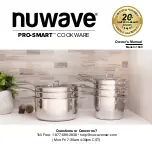
Some parts are dishwasher-safe and other parts aren't. (Please see below.) If it is dishwasher-safe,
please use a neutral detergent when cleaning. Some dishwashers may not be compatible with
pots/frying pans so please check the instruction manual of your dishwasher before use.
Dishwasher Compatibility:
Pot/frying pan part: YES
Special handle: YES
Cooking lid: (excluding knob of magnet-types): YES
Detachable lid knobs of magnet-types: NO (It may result in rusting)
Storage seal lid: NO (It may result in deformation)
To prolong the life of your pan, we recommend hand washing with a non-abrasive sponge.
Dishwasher use: it is preferable to use gentle detergents such as a liquid or gel.
THE NON-STICK COATING IN MY FRYING PAN IS NOW STICKING -
WHY?
• A build up of food deposits/residue may have formed on the pan which may originally be the
result of an item of food being allowed to overcook in the pan. This can normally be cleaned by
filling the pan with water and washing up liquid and leaving overnight. Then use a paste made up
of bicarbonate of soda and water rubbed gently over the pan with a non-abrasive sponge (a non-
stick scouring sponge). The non-stick coating should then be reconditioned with a little cooking oil
wiped over the surface with a paper kitchen towel.
• The frying pan may have been overheated causing damage and discolouration to the non-stick
coating. When pans are regularly overheated this will lead to a weakening of the non-stick coating.
The red Thermo-Spot in frypans is a heat indicator and tells you when the pan has reached the
perfect cooking temperature. When the spot turns solid red reduce the heat to maintain the
temperature. Do not continue to heat the pan on a high heat as this will result in the pan and the
non-stick surface becoming overheated.
• If cleaned in a dishwasher, after each use re-coat the non-stick interior with cooking oil to prevent
the non-stick from drying out and ensure the best non-stick performance.
THE BASE OF MY PAN IS NOT EVEN AND HAS BECOME WOBBLY -
WHY?
• The pan has been used on too high a heat or the wrong source of heat for the pan which has
resulted in the pan base becoming warped and distorted.
• Also never put cold water into a hot pan or plunge hot cookware in cold water. Sudden changes of
temperature may cause the metal to warp, resulting in an uneven base.
MY PAN SEEMS UNSTABLE ON MY HOB - WHY?
Take care when placing pans on gas hobs as the number of support legs vary and small pans in
particular may need a trivet, which most gas hob manufacturers will supply with their hob or can be
bought from the separately.
















